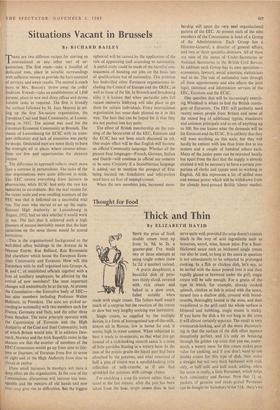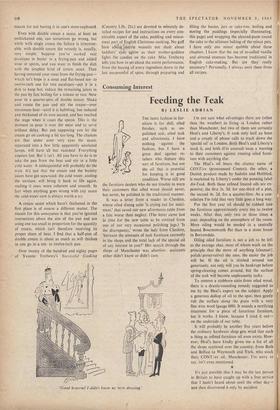Thought for Food
Thick and Thin
By ELIZABETH DAVID SINCE the price of fresh double cream went up from ls. 9d. to 2s. a quarter-pint I've made two or three attempts at using single cream (now Is. 2d: a quarter) instead.
Single cream, as supplied by the multiple dairies, is a form of homogenised top-of-the-milk, almost nil in flavour, low in butter fat and, it seems, high in water content. When subjected to heat it tends to re-separate, so that what you get instead of a rich-looking smooth sauce is a mass of little particles floating in a watery base. In the case of the potato gratin the liquid part had been absorbed by the potatoes, and what remained of half a pint of cream was a squalid-looking little collection of milk-crumbs, as if one had sprinkled the potatoes with cottage cheese.
For enriching a soup (in texture rather than in taste) at the last minute, after the pan has been taken from the heat, single cream does in fact serve quite well, provided the soup doesn't contain much in the way of acid ingredients such as tomatoes, sorrel, wine, lemon juice. For a flour- thickened sauce such as béchamel single cream can also be used, so long as the sauce in question is not subsequently to be subjected to prolonged cooking. In a fish or chicken dish, let's say, to be served with the sauce poured over it and then rapidly glazed or browned under the grill, single cream will be safe enough. For a gratin of the type in which, for example, already cooked spinach, chicken or fish is mixed with the sauce, turned into a shallow dish, covered with bread- crumbs, thoroughly heated in the oven, and then transferred to the grill until the whole surface is blistered and bubbling, single cream is tricky. If you leave the dish a bit too long in the oven it will almost certainly separate. The result is very amateurish-looking, and all the more disconcert- ing in that the surface of the dish often appears deceptively perfect, and it's only on breaking through the golden top crust that you see, under- neath, a watery mess. So thin cream makes poor value for cooking, and if you don't want to use double cream for this type of dish, then make a straight but not very thick béchamel with milk only, or half milk and half stock, adding, when the sauce is ready, a little Parmesan, which helps both consistency and flavour. Now that I I oz. packets of genuine and ready-grated Parmesan can be bought (at Sainsbury's) for I Id_ there's no
reason for not having it in one's store-cupboard.
Even with double cream a sauce, at least an unthickened one, can sometimes go wrong, but while with single cream the failure is irrecover- able. with double cream the remedy is. usually, very simple. Suppose you've cooked veal escalopes in butter in a frying-pan and added wine or spirits, and you want to finish the dish with the simplest kind of cream sauce. Then having removed your meat from the frying-pan- which let's hope is a stout and flat-based ten- to twelve-inch one for two escalopes—put it in a dish to keep hot, reduce the remaining juices in the pan by fast boiling for a minute or two. Now pour in a quarter-pint of double cream. Shake and rotate the pan and stir the cream—over maximum heat—until it is bubbling, has reduced and thickened of its own accord, and has reached the stage when it coats the spoon. This is the moment to pour it over the meat and to serve without delay. But just supposing you let the cream go on cooking a bit too long. The chances are that under your very eyes the sauce, separated into a few little apparently unrelated lumps. will have all but vanished Everything appears lost. But it isn't. All you have to do is to take the pan from the heat and stir in a little cold water. A tablespoonful will probably do the trick. It's just that the cream and the buttery juices have got separated: the cold water, cooling the mixture. will bring it back to life again, making it once more coherent and smooth. In fact when anything goes wrong with any sauce the cold-water cure is always worth a try.
A cream sauce which hasn't thickened in the first place is of course a different matter. The reason for this annoyance is that you've ignored instructions about the size of the pan and are using one too small in proportion for the quantity of cream, which isn't therefore receiving its proper share of heat. I find that a half-pint of double cream is about as much as will thicken in one go in a ten- to twelve-inch pan.
Over twenty of the hundred and eighty pages of Yvonne • Trethewy's Successful Cooking (Country Life, 21s.) are devoted to minutely de- tailed recipes for and instructions on every con- ceivable aspect of the cake, pudding and mince- meat part of English Christmas cooking. No guff here about 9rmerrie wassails nor slush about toddlers' eyes aglow as their mother-goddess lights the candles on the cake Miss Trethewy tells you how to set about the entire performance, from the buying of every ingredient down to the last teaspoonful of spice. through preparing and
filling the basins, jars or cake-tins, boiling and storing the puddings (especially illuminating, this page) and wrapping the almond-paste round the cake to the ultimate baking of the mince pies. I have only one minor quibble about these chapters. I know that the use of so-called vanilla and almond essences has become traditional in English cake-making. But are they really necessary? Personally, I always omit them from all recipes.















































 Previous page
Previous page